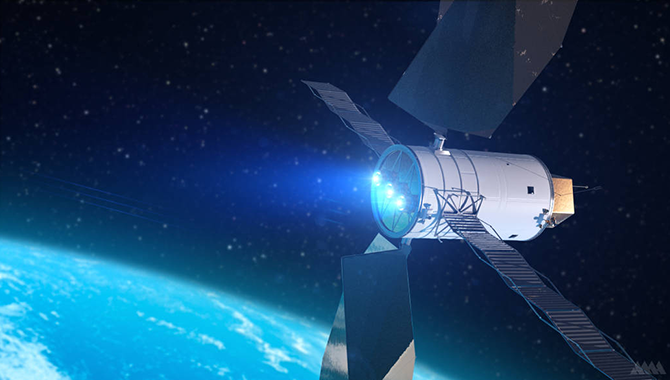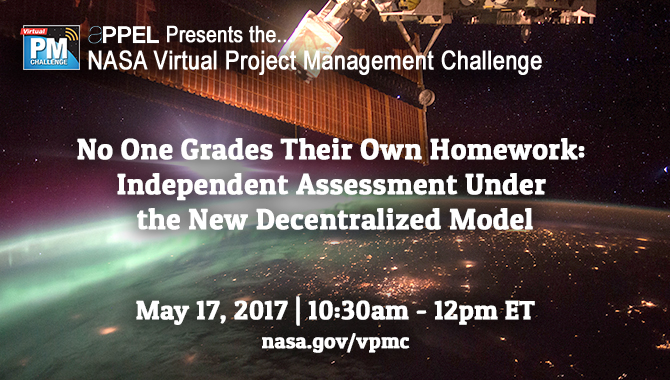
Artist’s concept of a solar electric propulsion system.
Photo Credit: Analytical Mechanics Associates
Based on decades of development, high-power solar electric propulsion (SEP) is preparing to fuel deep space exploration.
As NASA moves further along the path toward manned missions to Mars, the agency is actively investigating propulsion systems that enhance efficiency and mission flexibility compared with traditional chemical propellant. SEP, which has been under development at Glenn Research Center (GRC) since the 1960s, fits the bill.
SEP works in conjunction with solar arrays to provide greater “gas mileage”: it enables spacecraft to travel farther while using less fuel. This has multiple cost-saving benefits. Because less fuel is required to go a given distance, missions need to carry less propellant and so can use smaller spacecraft and, therefore, smaller launch vehicles. Another option is to keep the spacecraft the same size but increase the payload by utilizing space traditionally reserved for chemical fuel.
“I think the real takeaway…is that it gives you that option space. Where chemical is restrictive in its overall mechanics, the SEP systems—solar electric propulsion systems—allow you those trades and allow you to either step down in launch vehicle class or increase cargo,” said Bryan Smith, director of the Space Flight Systems Directorate at GRC.
Already, lower-power SEP systems have supported robotic initiatives such as the Dawn mission, which utilizes ion thrusters powered by electricity from solar panels. SEP has been used for a range of other applications as well, including commercial satellite operations.
“The infusion of this technology into the commercial satellite industry has taken place over the years, and has displaced a lot of the propellant that the commercial satellites used to have to take up in order to do their station keeping operations. And by displacing that propellant, you can either use the additional mass for additional revenue-generating transponders or you could have a longer life, which both turn into a better revenue stream for a lot of operators,” said Smith.
Now, advances in SEP technology are expected to more than double the capability of current systems, expanding its utility for deep space missions. “We [already] can develop smaller spacecraft that can be propelled by solar propulsion versus chemical propulsion. But the advance here is the higher power and the higher thrust,” said Steve Jurczyk, associate administrator for the Space Technology Mission Directorate (STMD).
To propel the technology forward, NASA awarded a contract to Aerojet Rocketdyne to design and develop a high-power SEP system that will fuel missions beyond low Earth orbit (LEO). The agency hopes to use it to support the Asteroid Redirect Robotic Mission (ARRM), a key element in NASA’s Journey to Mars. SEP could also be used for robotic missions to Mars to collect and return samples, and to support human exploration by delivering cargo to Mars that will allow humans to live and work on the planet’s surface.
NASA isn’t the only organization interested in this technology. “Other agencies would like it for its efficiency and operational flexibility, and then commercial companies would also love to have this capability. For example, companies are looking at “all electric” commercial communications satellites. They’ve been used electric propulsion for station keeping in geostationary orbit for years, but this would allow them to more rapidly get systems from geostationary transfer orbit to geo orbit for comm capabilities, or get larger systems from geostationary transfer orbit to geo,” said Jurczyk.
Aerojet Rocketdyne is beginning work to refine the capability so that it can be produced on a large scale for a variety of mission types. The current contract with NASA supports technology development through the critical design review phase. If the technology proves out as expected, the agency will exercise the option to purchase multiple SEP units.
After that, things will move quickly for SEP and ARRM. “[W]e’re looking at launching in the 2020-2021 timeframe,” said Jurczyk.
Eventually, in combination with other technology being developed by the STMD, SEP could transform orbital transfer and other spaceflight operations. “If you look at the arrays, the high-power arrays that the space technology mission directorate has developed, and you couple that with this—I call it—new engine system, we basically are building a new drive train. It enables whole new platforms for deep space exploration,” said Smith.
Learn more about NASA’s solar electric propulsion project in this video.
View a video about the robotic segment of the Asteroid Redirect Mission









